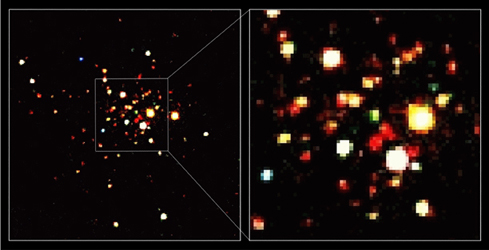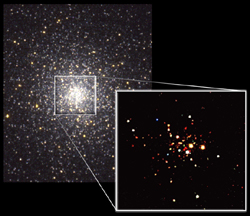May 17, 2001
CXC PR: 01-08

These Chandra images show an enlarged view of the central region (right) and a full-field view (left) of the globular cluster 47 Tucanae.
Press Image and Caption
Scientists have gazed into an incredibly dense star cluster with NASA's Chandra X-ray Observatory and identified a surprising bonanza of binary stars, including a large number of rapidly rotating neutron stars. The discovery may help explain how one of the oldest structures in our Galaxy evolved over its lifetime.
By combining Chandra, Hubble Space Telescope, and ground-based radio data, the researchers conducted an important survey of the binary systems that dominate the dynamics of 47 Tucanae, a globular cluster about 12 billion years old located in our Milky Way galaxy.
Most of the binaries in 47 Tucanae are systems in which a normal, Sun-like companion orbits a collapsed star, either a white dwarf or a neutron star. White dwarf stars are dense, burnt-out remnants of stars like the Sun, while neutron stars are even denser remains of a more massive star. When matter from a nearby star falls onto either a white dwarf or a neutron star, as in the case with the binaries in 47 Tucanae, X-rays are produced.

This composite image shows relation of the Chandra image of 47 Tucanae to ground-based, optical observations.
"This Chandra image provides the first complete census of compact binaries in the core of a globular cluster," said Josh Grindlay of the Harvard-Smithsonian Center for Astrophysics (CfA) and lead author of the report that appears in the May 18 issue of Science. "The relative number of neutron stars versus white dwarfs in these binaries tell us about the development of the first stars in the cluster, and the binaries themselves are key to the evolution of the entire cluster core."
Many of the binaries in 47 Tucanae are exotic systems never before seen in such large quantities. Perhaps the most intriguing are the "millisecond pulsars", which contain neutron stars that are rotating extremely rapidly, between 100 to nearly 1000 times a second.
"The Chandra data, in conjunction with radio observations, indicate that there are many more millisecond pulsars than we would expect based on the number of their likely progenitors we found," said co-author Peter Edmonds, also of the CfA. "While there is a general consensus on how some of the millisecond pulsars form, these new data suggest that there need to be other methods to create them."
In addition to the millisecond pulsars, Chandra also detected other important populations of binary systems, including those with white dwarf stars and normal stars, and others where pairs of normal stars undergo large flares induced by their close proximity.
The Chandra data also indicate an apparent absence of a central black hole. Stellar-sized mass black holes -- those about five to ten times as massive as the Sun -- have apparently not coalesced to the center of the star cluster. All or most stellar-sized black holes that formed over the lifetime of the cluster have likely been ejected by their slingshot encounters with binaries deep in the cluster core.
"These results show that binary star systems are a source of gravitational energy which ejects stellar mass black holes and prevents the collapse of the cluster’s core to a more massive, central black hole," said the CfA's Craig Heinke. "In other words, binary systems – not black holes - are the dynamical heat engines that drive the evolution of globular clusters."
Chandra observed 47 Tucanae on March 16-17, 2000, for a period of 74,000 seconds with the Advanced CCD Imaging Spectrometer (ACIS).
The ACIS X-ray camera was developed for NASA by Penn State and the Massachusetts Institute of Technology. The High Energy Transmission Grating Spectrometer was built by MIT. NASA's Marshall Space Flight Center in Huntsville, AL, manages the Chandra program. TRW, Inc., Redondo Beach, California, is the prime contractor for the spacecraft. The Smithsonian's Chandra X-ray Center controls science and flight operations from Cambridge, MA.
Images associated with this release are available on the World Wide Web at:
MEDIA CONTACTS
Steve Roy
Marshall Space Flight Center, Huntsville, AL
Phone: 256-544-6535
Megan Watzke
Chandra X-ray Observatory Center, CfA, Cambridge, MA
Phone: 617-496-7998


